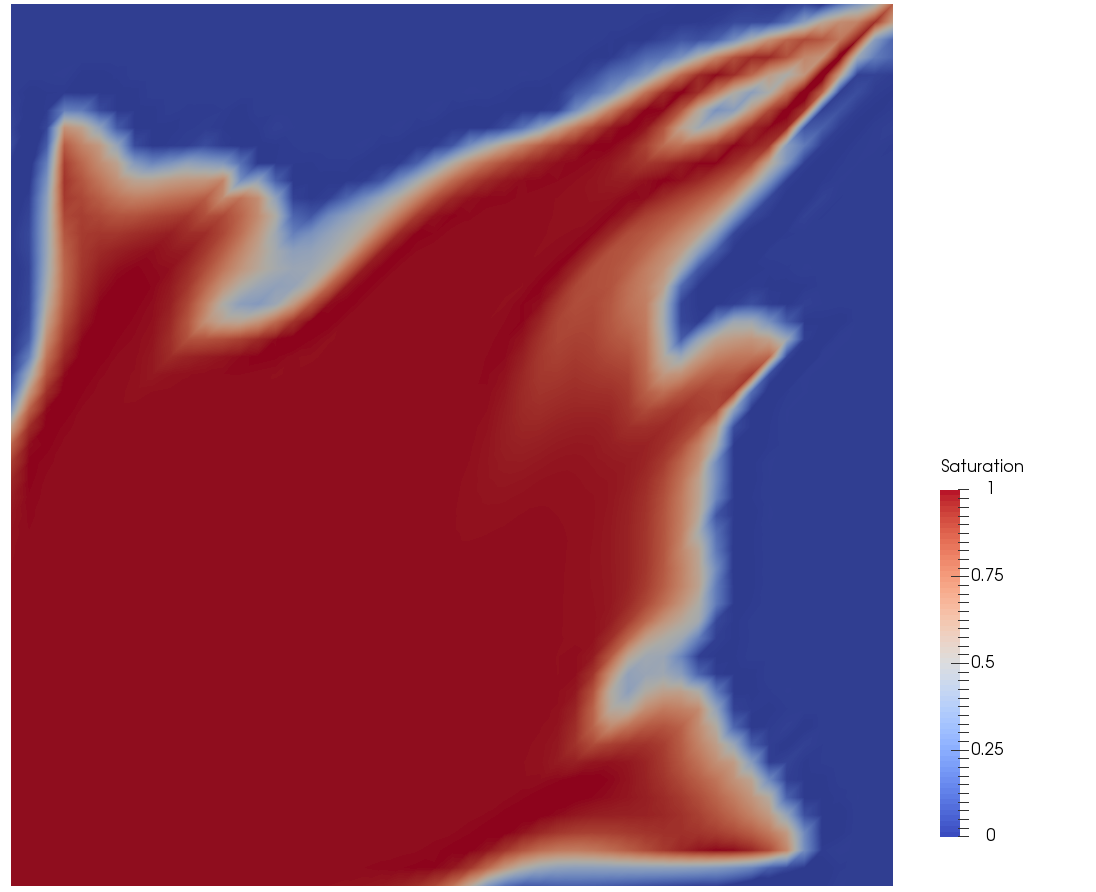Prof. Martin O. Saar, ETH Zurich
Description
Introduction
 Saturation field of water (blue) in oil (red); flow from lower left to upper right corner; simulated with our preliminary two-phase flow solver
Saturation field of water (blue) in oil (red); flow from lower left to upper right corner; simulated with our preliminary two-phase flow solver
The ability to computationally simulate multiphase-multicomponent fluid flow, coupled with geochemical reactions between fluid species and rock minerals, in porous and/or fractured subsurface systems is of major importance to a vast number of applications. These include (1) carbon dioxide storage in geologic formations, (2) geothermal energy extraction, (3) combinations of the latter two applications during CO2-Plume Geothermal energy extraction (Randolph and Saar, 2011), (4) waste fluid and (nuclear) waste storage, as well as (5) groundwater and contaminant transport. Modeling these systems with such a wide variety of coupled physical and chemical processes is both challenging and computationally expensive because chemical reactions can strongly affect subsurface flow paths due to changes in rock porosity and permeability as a result of mineral dissolution and/or precipitation.
In this work we present a new approach to develop a simulator for multicom-ponent-multiphase flow and reactive transport in porous media by using state of the art numerical tools, namely FEniCS (fenicsproject.org) and Reaktoro (reaktoro.org). The governing partial differential equations for fluid flow and transport are solved using FEniCS, which enables fast and efficient implemen-tation of computer codes for the simulaton of complex physical phenomena using finite element methods in unstructured meshes. FEniCS supports a wide range of finite element schemes (e.g., continuous and discontinuous Lagrange, Raviart–Thomas, etc.) of special interest in porous media flow. In addition, FEniCS interfaces with many sparse linear solvers (e.g., PETSc, UMFPACK) and provides convenient tools for adaptive mesh refinement and the capability of massive parallel calculations.
A fundamental component of our contribution is the coupling of our FEniCS-based flow and transport solver with our chemical reaction simulator, Reaktoro, which implements efficient, robust, and accurate methods for chemical equilib-rium and kinetics calculations (Leal et al., 2015, 2016a,c,b) at every node of the mesh, at every time step. These numerical methods for reaction modeling have been especially developed for perfomance-critical applications such as re-active transport modeling, where modern numerical optimization methods are applied to the solution of the chemical equations. Furthermore, Reaktoro is also used for the calculation of thermodynamic properties of rock minerals and fluids (brine and gases) as functions of temperature, pressure, and composition. The proposed simulator can, however, be coupled with other backends for the calculation of both thermodynamic and thermophysical properties of rock min-erals and fluids. We present several example applications of our new approach, demonstrating its capabilities and computation speed.
References
Leal, A. M. M., Blunt, M. J., and LaForce, T. C. (2015). A chemical kinetics algorithm for geochemical modelling. Applied Geochemistry, 55:46–61.
Leal, A. M. M., Kulik, D. A., and Kosakowski, G. (2016a). Computational methods for reactive transport modeling: A Gibbs energy minimization ap-proach for multiphase equilibrium calculations. Advances in Water Resources, 88:231–240.
Leal, A. M. M., Kulik, D. A., Kosakowski, G., and Saar, M. O. (2016b). Computational methods for reactive transport modeling: An extended law of mass-action, xLMA, method for multiphase equilibrium calculations. Advances in Water Resources, 96:405–422.
Leal, A. M. M., Kulik, D. A., and Saar, M. O. (2016c). Enabling Gibbs energy minimization algorithms to use equilibrium constants of reactions in multi-phase equilibrium calculations. Chemical Geology, 437:170–181.
Randolph, J. B. and Saar, M. O. (2011). Coupling carbon dioxide sequestration with geothermal energy capture in naturally permeable, porous geologic for-mations: Implications for CO2 sequestration. Energy Procedia, 4(May):2206–2213.


